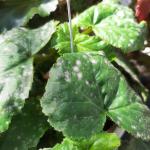Powdery mildew has been observed on begonias in a greenhouse this week. Powdery mildew is one of the most common and easily recognized diseases in greenhouse crops. The distinctive whitish colonies on leaves are composed of fungal mycelium and spores (conidia). Colonies typically form on the upper surfaces of leaves but may also appear on leaf undersides, stems, petioles, and flowers. Leaves may become distorted, and severe cases can lead to defoliation.
Most species of powdery mildew are specific to hosts in a single plant family. Disease development is favored by high relative humidity (> 95%), moderate temperatures (68º-86ºF), and low light intensities.
Powdery mildew management:
- Scout crops on a regular basis for powdery mildew.
- Rogue infected plants. Immediately place diseased material into a plastic bag to prevent spores from spreading.
- Grow powdery mildew resistant cultivars when available.
- Avoid overcrowding of plants and provide good air circulation.
- Keep relative humidity levels low in the greenhouse
- Clean greenhouses thoroughly between crops.
- Eliminate weeds in and around the greenhouse.
- Several conventional and organic products are available. For a full list, please see the New England Greenhouse Floriculture Guide.
- Dr. Angela Madeiras, Extension Educator & Diagnostician, UMass Extension Plant Diagnostic Lab
